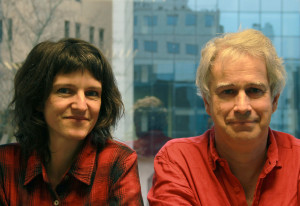Armelle Andro and Michel Bozon
tell us about INED’s “ Demography, Gender and Societies” research team

Armelle Andro is a demographer, an associated researcher at INED and associate professor at the Institut de Démographie of the University of Paris 1. Michel Bozon is a sociologist, an INED research director and associated researcher at the Institut de Recherche Interdisciplinaire sur les Enjeux Sociaux (IRIS [Institute of interdisciplinary research on social issues]) of the Ecole des Hautes Etudes en Sciences Sociales (EHESS) and the University of Paris 13. Andro and Bozon have both directed INED’s Demography, Gender and Societies research unit.
(Interview conducted in December 2014)
The Demography, Gender and Societies research unit was founded in 1999. In what context and to what end?
Demography as a discipline was not really at the forefront of women’s studies or gender studies, either in France or elsewhere. The Gender research unit was created in 1999 not so much in connection with activist concerns or French feminist research of the time (particularly in history and sociology) as it was a kind of consequence of an international political mobilization in favour of equality between men and women. In the 1990s, three major United Nations conferences were held: the Vienna conference on human rights (1993), the population and development conference in Cairo (1994), and the Beijing conference on women (1995); all of them called for developing research that would help support and guide policy to achieve equality. In 1997, about ten researchers, including the Africanist demographer Thérèse Locoh, the demographer Stéphanie Condon, Andro Armelle, who was then a PhD student in demography, and the sociologist Michel Bozon, created a study group on gender and demography at INED. It was this group that evolved two years later into the Gender research unit, which conducts detailed studies of change in gender relations and comparative studies across societies.
How does the gender studies perspective inform the research done in the Gender unit?
Our primary characteristic is transversality. Almost all INED team members also belong to other research units and other institutions (as associated researchers). Gender unit researchers also come from a wide variety of disciplines—history, economics, sociology, geography, public health—and work in all areas of demography, and in Southern as well as Northern countries. The unit’s most noteworthy studies include the ENVEFF survey (2000) on violence against women, conducted by the Centre de Recherche en Démographie at the University of Paris 1 in collaboration with INED; the Famille et Employeurs survey (2004), conducted jointly with INED’s Economic Demography team; the Contexte de la Sexualité en France survey (2006), conducted in partnership with INSERM; the Excision et Handicap survey on female genital mutilation (2007-2009); the surveys we have been conducting for over two decades in rural Mali; and the DéfiChine survey currently underway on the effects of the “shortage of women” in China on gender relations and sexuality there.
How does the unit’s research on these questions relate to public debate?
The issue of equality between men and women has been at the centre of public debate for several decades now. The role of demographic research is to furnish tangible empirical material that will help substantiate and clarify that debate. What do we mean when we speak of gender inequality? How widespread is it and what factors are involved? The VIRAGE survey on gender-related violence and the ENVEFF survey that preceded it are responses to strong demand from both civil society and the public authorities. Issue number 517 of Population & Societies, authored collectively by Gender unit researchers and published this December 2014, is entitled precisely “A Demographic Perspective on Gender Inequality.” Another collective study by the unit, entitled Atlas Mondial des Femmes: les Paradoxes de l’Emancipation, will be published in January 2015. There we worked to compare different societies, showing how relations between men and women necessarily involve power and its effects and generate inequalities in all spheres of society.
In what ways has research evolved in addressing the issue of gender relations? What new research fields are opening up today?
While early research focused on the situation of women, the current approach is a more integrated one concerning what can be called gender systems; that is, the way relations between the sexes, but also between types of sexuality, fit together with asymmetrical, hierarchical relations. Gender is the result of a learning process that encompasses all relations involving male and female. Though we continue to study inequalities at work and in the family, the focus of our questions is shifting to different types of masculinity and to heteronormativity.
